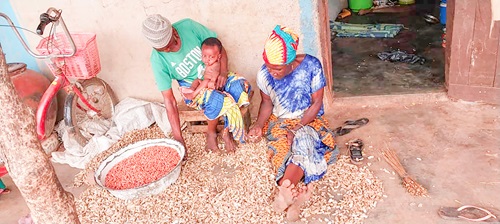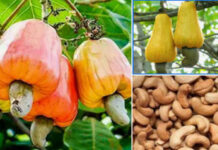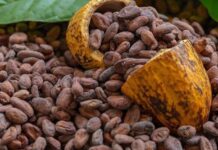Aishetu Fusheini, a 65-year-old farmer, stares blankly at a bag of groundnuts, her last yield from her two-acre farm. She had expected a higher yield, but drought and heat have conspired to rob her harvest.
She ended up with four bags, which could have been twice that or more. Three and a half bags were sold to feed her household, and the reserve is seed for the new planting season.
Northern Ghana, considered one of the country’s food baskets, experiences only one rainy season, resulting in prolonged flooding, and then drought. This climatic difference impacts food production and worsens poverty and food insecurity.
Aishetu, a single mother, is worried that the food she has for her household of 10 adults and five children below 13 years, will not last long.
Food insecurity is a daily headache for Aishetu, despite vast stretches of land surrounding her house. As a farmer who intercrops groundnut and okro, she recognises that food is very important for survival and it is painful to deny her children or herself food because she does not have the means to provide it.
Malia Mohammed, another farmer, shares a similar story. She walks three miles to her two-acre land to plant groundnuts and soya beans on an empty stomach. She hopes to sell part of the groundnuts and keep the rest and the soya for consumption.
Her household of 15, comprising nine men and six women with eight children between four months and eight years, is concerned about the food shortage situation, which has been getting worse over the past two years.
Mahama Ziblim, a 33-year-old farmer living with a disability, cultivates soya beans, groundnuts and maize on his three-acre land for his household of 16 people.
Part of the harvest is sold to cater for toiletries, but when the family runs out of food, he is compelled to work for an aggregator who engages people to bag soya beans.
Vulnerability analysis
Experts attribute food insecurity in the region to factors such as inconsistent rainfall patterns, climate change, pest- infestation, poor road infrastructure, lack of access to finance, inadequate market, post-harvest losses and unsustainable farming systems.
In recent times, COVID-19 and the Russian-Ukraine war have also disrupted the global agricultural supply chain, leading to food insecurity.
Household food security is an issue that affects populations around the world, with food insecurity remaining a serious challenge for many households in Ghana, particularly among smallholder farmers.
The Ghana Statistical Service (GSS) and the Ministry of Food and Agriculture (MOFA) have implemented the Comprehensive Food Security and Vulnerability Analysis (CFSVA) to measure food insecurity among the population.
The CFSVA has revealed that households that depend mainly on agriculture as their source of household income, unskilled labour, household heads who are less educated, and remittances-dependent households are more likely to be food insecure.
The study also found that the Northern Region has the highest level of food insecurity, with 598,706 people experiencing food insecurity, followed by the Upper East Region with 634,293 people.
CFSVA Project Coordinator at the Ghana Statistical Service, Dr Peter Takyi Peprah, explained that the regions with the highest level of food insecurity are also the areas most prone to adverse weather conditions, such as floods and droughts.
He said those regions were disproportionately affected by food prices during their lean season and bumper season.
Worrying statistics
He pointed out that the districts in the country facing the highest rates of food insecurity were Kassena Nankana West District with about 78.8 per cent; Karaga, 75.9:per cent; Builsa South, 74.5 per cent; Tatale, 68.4 per cent; Bolgatanga East, 66.3 per cent; Kumbungu, 61.2 per cent; Jirapa, 61 per cent; Chereponi 60.3 per cent; Tempane 59.2 per cent; and Bongo, 57.3 per cent.
He was, however, quick to indicate that food insecurity was not only predominant in northern Ghana but there were also pockets of areas in Southern Ghana where the population were food insecure.
He said 71.4 per cent of the population in Tarkwa-Nsuaem district in the Western Region were food insecure while food insecurity was also prevalent in Ada West in the Greater Accra Region, where 35.9 per cent of the population were experiencing the phenomenon, with Sekyere Afram Plains, in the Ashanti Region, 34 per cent; Ayensuano in the Eastern Region, 31.7 per cent: and Asunafo South in the Ahafo Region, 31.4 per cent.
SOS
Organisations such as the USAID through the Feed The Future initiative and the World Food Programme are targeting food security interventions in districts in northern Ghana, where poverty and nutrition statistics are the poorest. However, Aishetu, Malia, and Mahama believe the government needs to do more in supporting peasant farmers with farm inputs, reducing the price of fertiliser, and making farming equipment available at reduced prices.
The government must put in interventions to address the food insecurity situation in the country, as everyone deserves to have access to food, which is a basic need.
Farmers in Karaga applaud the government for initiating the agricultural development project at Kasunya-Asutsuare in the Greater Accra Region aimed at promoting agricultural productivity and improving food security in the region.
They appeal to the government to implement similar projects with irrigation schemes, farm infrastructure, farmer training, funding and value addition which would contribute to the development of the agricultural sector, improve food security in the country by increasing the availability of fresh produce and reduce poverty in the country.








